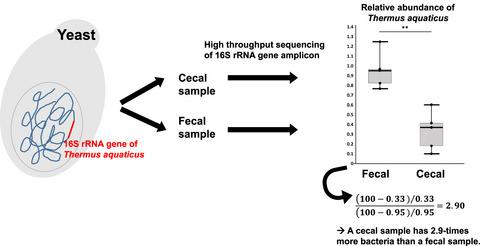当前位置:
X-MOL 学术
›
Microbiologyopen
›
论文详情
Our official English website, www.x-mol.net, welcomes your
feedback! (Note: you will need to create a separate account there.)
Measuring the absolute abundance of the microbiome by adding yeast containing 16S rRNA gene from a hyperthermophile
MicrobiologyOpen ( IF 3.9 ) Pub Date : 2021-07-23 , DOI: 10.1002/mbo3.1220 Ju Yeong Kim 1, 2 , Myung-Hee Yi 1 , Myungjun Kim 1 , Seogwon Lee 1 , Hye Su Moon 3 , Dongeun Yong 3 , Tai-Soon Yong 1
MicrobiologyOpen ( IF 3.9 ) Pub Date : 2021-07-23 , DOI: 10.1002/mbo3.1220 Ju Yeong Kim 1, 2 , Myung-Hee Yi 1 , Myungjun Kim 1 , Seogwon Lee 1 , Hye Su Moon 3 , Dongeun Yong 3 , Tai-Soon Yong 1
Affiliation

|
High-throughput sequencing (HTS) of 16S rRNA gene amplicons provides compositional information regarding the microbial community, but not the absolute abundance of the bacteria. We aimed to develop a standardized method for quantifying the absolute abundance of bacteria in microbiome studies. To demonstrate the utility of our approach, we quantified the number of bacteria from the compositional data of the fecal and cecal microbiomes. The 16S rRNA gene of a hyperthermophile, Thermus aquaticus, was cloned into Pichia pastoris (yeast) genome, and an equivalent amount of the yeast was added to the stool and cecal samples of mice before DNA extraction. 16S rRNA gene library construction and HTS were performed after DNA extraction. The absolute abundances of bacteria were calculated using T. aquaticus reads. The average relative abundances of T. aquaticus in the five stool and five cecal samples were 0.95% and 0.33%, respectively, indicating that the number of bacteria in a cecum sample is 2.9 times higher than that in a stool sample. The method proposed for quantifying the absolute abundance of the bacterial population in this study is expected to overcome the limitation of showing only compositional data in most microbiome studies.
中文翻译:

通过添加含有来自超嗜热菌的 16S rRNA 基因的酵母来测量微生物组的绝对丰度
16S rRNA 基因扩增子的高通量测序 (HTS) 提供有关微生物群落的组成信息,但不能提供细菌的绝对丰度。我们的目标是开发一种标准化方法来量化微生物组研究中细菌的绝对丰度。为了证明我们的方法的实用性,我们根据粪便和盲肠微生物群的组成数据量化了细菌的数量。将超嗜热菌水生栖热菌的 16S rRNA 基因克隆到毕赤酵母(酵母)基因组中,并在提取 DNA 之前将等量的酵母添加到小鼠粪便和盲肠样本中。 DNA提取后进行16S rRNA基因文库构建和HTS。使用T计算细菌的绝对丰度。水生读。 T的平均相对丰度。 5个粪便样本和5个盲肠样本中的水生弧菌含量分别为0.95%和0.33%,表明盲肠样本中的细菌数量是粪便样本中的2.9倍。本研究中提出的用于量化细菌种群绝对丰度的方法有望克服大多数微生物组研究中仅显示组成数据的限制。
更新日期:2021-07-24
中文翻译:

通过添加含有来自超嗜热菌的 16S rRNA 基因的酵母来测量微生物组的绝对丰度
16S rRNA 基因扩增子的高通量测序 (HTS) 提供有关微生物群落的组成信息,但不能提供细菌的绝对丰度。我们的目标是开发一种标准化方法来量化微生物组研究中细菌的绝对丰度。为了证明我们的方法的实用性,我们根据粪便和盲肠微生物群的组成数据量化了细菌的数量。将超嗜热菌水生栖热菌的 16S rRNA 基因克隆到毕赤酵母(酵母)基因组中,并在提取 DNA 之前将等量的酵母添加到小鼠粪便和盲肠样本中。 DNA提取后进行16S rRNA基因文库构建和HTS。使用T计算细菌的绝对丰度。水生读。 T的平均相对丰度。 5个粪便样本和5个盲肠样本中的水生弧菌含量分别为0.95%和0.33%,表明盲肠样本中的细菌数量是粪便样本中的2.9倍。本研究中提出的用于量化细菌种群绝对丰度的方法有望克服大多数微生物组研究中仅显示组成数据的限制。











































 京公网安备 11010802027423号
京公网安备 11010802027423号